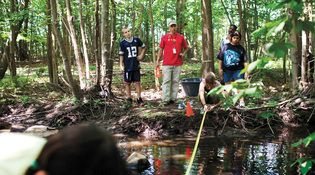 loading
loading
featuresWest Campus: Walk on the semi-wild sideWest Campus woods inspire nature programs.  Christopher CapozzielloWest Campus naturalist Tom Parlapiano (in red shirt) supervises students in a summer program. View full image
The West Campus has a secret. In addition to the high-tech laboratories, well-manicured lawns, and expanse of asphalt parking lots that Yale acquired when it bought the Bayer HealthCare complex three years ago, it got something else: a forest. Sort of. “Woods might be a generous term,” admits veteran naturalist Tom Parlapiano, West Campus education coordinator for the Peabody Museum. “Let’s say that what we have here is a highly culturally impacted forested area.” Bayer left about 30 acres of its campus relatively undeveloped, as a kind of respite-and-recharging place for employees. (This includes some 15 acres of wetlands that are subject to building restrictions.) There are two separate tracts, joined by the Oyster River. The southwest branch, which was probably once a landfill, now harbors a mix of wetlands and trees. There are native species, from cattails to red maples, and invasives such as Asiatic bittersweet and autumn olive. In the northeast tract, hiking trails thread a serene woodlot of oaks, beeches, and birch trees. There’s a fine pond, a stone bridge that spans the river (more of a creek at this point in its run) and, in late summer, the electric whine of cicadas. “It’s perfect—maybe a little too perfect,” says Parlapiano. “Sometimes it looks as if Bayer engineered the landscape.” On a recent walk, Parlapiano stopped suddenly. “There’s a downy woodpecker,” he said. West Campus bird-watchers have tallied almost 100 species in the past year, and the Peabody has begun cataloguing the area’s biological diversity. Eventually, Parlapiano hopes to enlist Yale’s environment school in developing a land management strategy that would include replacing the invasive plants with native species. When he isn’t clearing trails, Parlapiano is planning and running programs such as nature-oriented summer camps and environmental education classes. “As a kid growing up in rural New Jersey, I was out in the woods all the time finding salamanders, snakes, turtles, and the like,” he says. “I was stunned by how many kids around here are really afraid to be in the woods. We can change that attitude, teach them to appreciate the natural world. We can also help let the kid in them come out.”
The comment period has expired.
|
|